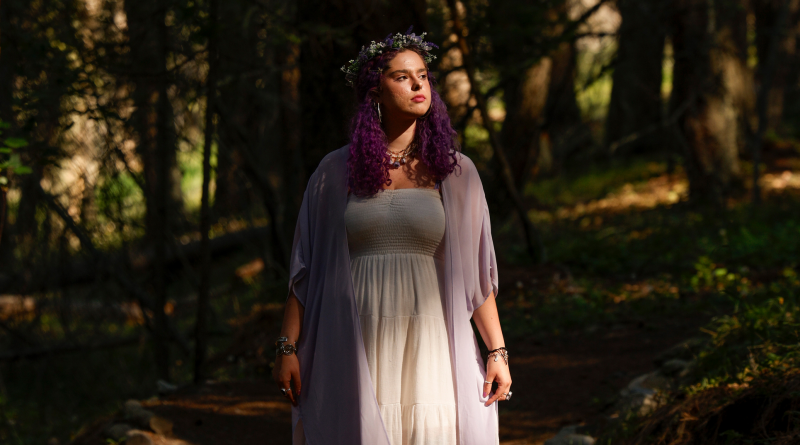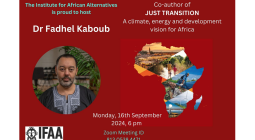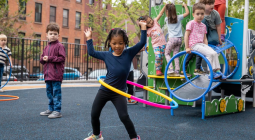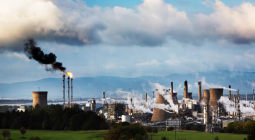How to Talk to Anxious Children About Climate Change

Olivia Vesovich, one of 16 youth plaintiffs in Held v. Montana, on her favorite hiking trail in Missoula, Montana in July 2023. Credit: Tailyr Irvine/The Washington Post via Getty Images.
At 21, Olivia Vesovich has already put more on the line for the climate fight than most people, regardless of age. In 2020, Vesovich was just 16 and wrapping up her sophomore year of high school when she decided to sacrifice her privacy and step onto the national stage as one of the 16 youth plaintiffs represented by Our Children’s Trust in the Held v. Montana lawsuit.
Vesovich first heard about the search for plaintiffs when the faculty advisor for Students Against Violating the Environment (SAVE) approached the club members at Hellgate High School in Missoula about the possibility of signing on as plaintiffs in the suit seeking to hold the Montana state government accountable for not doing more to counter the worsening climate crisis.
Confidently quirky with a broad smile and her signature purple hair, Vesovich was the only Held plaintiff to testify in court directly about her climate despair. “I felt paralyzed… like I couldn’t live my life, because I knew that every single action I took I was helping destroy the planet. I was so afraid to consume anything,” said Vesovich, whose crippling guilt over her environmental impact extended even to food and water.
Only in the last two or three years have educators and therapists started to get a clear picture of just how much damage future uncertainty and feeling constantly unsafe from the planet itself can have on children and their developing minds. One long-time therapist compares the impact of climate change on children to child abuse, noting how in both instances children are betrayed by institutions or people they were meant to trust. Recently psychologists have coined the phrase “moral injury” to describe the wounds they suffer when they realize those supposedly safeguarding their wellbeing are actively harming them.
For the last two decades parents and educators have been muddling through climate discussions without any clear guidelines or idea of the consequences, thoughtlessly introducing kids to climate change without providing the proper emotional support. But this is now starting to change.
New curriculum is being developed to fill gaps between climate education and emotional support while educators and therapists work to help under-supported parents and other family members figure out how to talk to their children about climate change.
Such conversations are not easy, said psychiatrist Lise van Susteren, who thinks these “moral injuries” at such a young age can have lifelong consequences, leading to the loss of faith in social bonds, cynicism and anxious disconnection from others.
But van Susteren said that by presenting climate change in a more nuanced manner, parents and teachers can help kids feel empowered to take action, so that they feel like they are joining an ongoing fight instead of starting a battle they have already lost. And thanks to greater climate consciousness among therapists, and lawsuits like Held v. Montana, there is a growing push to provide more support for the parents and educators who face these tough conversations every day.
Renewable English
Harry Waters is one of the educators working to fill the gaps between climate education and emotional support. Waters, a long-time English teacher turned education consultant, had been incorporating climate change into his English curriculum for years when, in 2020, the pandemic gave him a needed push to create Renewable English for those learning English as a second language.
The curriculum focuses on combining English instruction with tools for climate action. Now, four years later, he works full-time as a climate education consultant, introducing other teachers to the Renewable English curriculum. It includes lessons for English learners about water waste and ocean pollution, including vocabulary words like “micro plastic” and “marine debris.” It also tests students’ listening comprehension by giving them a true/false quiz based on an information video on ocean plastic.
When he created Renewable English, a program which he first launched in the U.K. and is now sharing in Spain, Waters didn’t expect climate grief counseling to play such a large role in his work. But with child and adolescent mental health resources stretched near the breaking point and climate-aware therapists still few and far between, Waters has become the de facto climate counselor at the schools he visits.
One 12-year-old girl from Sevilla stands out in particular. When they first met, she was “this happy, bubbly kind of person, and the next year she was just a shadow of herself,” said Waters.
While she “hadn’t been hugely affected by any ecological event,” Waters said, she “had just gotten into the habit of doom scrolling and looking at how bad everything was.”
When the student became despondent, her teachers “just didn’t know how to deal with it,” said Waters. In cases like this, it is vital to involve the parents, family and wider community, he said.
When he first met with the student, “there wasn’t enough of a support network around her,” said Waters, who was only at the school occasionally, running workshops once or twice a month.
Waters took on the role of unofficial counselor, “trying to encourage her to look for her passion, to find something that she could make a difference with,” he said.
“It was kind of tragic,” said Waters. The most compassionate and empathetic kids most often get stuck in a doom spiral because they want to help so much that they forget to take care of themselves, he explained.
But students must be encouraged not to give up. “While it’s incredibly tempting, it’s not the answer,” he said. “We need people who have those strong feelings about the climate crisis to fight for what is right and what is good, because you care.”
Waters was eventually able to help the student start a letter writing campaign aimed at the parents and wider community around her school to try and raise funds for solar panels to power the school. “She thought it was just a small thing, but to have that focus, to look towards, it gave her purpose,” said Waters.
A Gen Z Board of Advisors
The challenges educators face in helping students cope with climate change, intellectually and emotionally, are equalled, if not surpassed, by the challenges confronting parents. Sarah Newman, founder and executive director of the Climate Mental Health Network, an organization devoted to normalizing conversations about climate anxiety, is creating guides that help parents talk to their kids about climate.
In support of that work, Newman created a board of advisors made up entirely of Gen Z members—people born between 1997 and 2012. Who better to help direct programing than the people they are aiming to support?
For now, the advisory board has been busy at work reviewing and giving input on resources for parents and teachers, helping create the guides fostering dialogue on the climate crisis between kids and parents.
The guides explain, said Newman, “that having climate emotions is a normal response to the climate crisis, to not be dismissive of what kids are going through, but to not be Pollyanna, either.” One resource, “The ABC’s and L’s of Talking Climate with Kids,” created by van Susteren, walks parents through tailoring a climate conversation with their children as individuals, starting with giving age appropriate information, tailoring the content to a child’s typical behavior (are they a quiet bookish animal lover who would gravitate towards knowledge of endangered species, or an athletic extrovert who might be more interested in learning how bad air quality makes it harder to play outside?). And finally keep in mind the conditions in which a child is growing up.
A conversation with a child whose house burnt down in a wildfire would need a different approach than a climate talk with a kid who has only ever seen the effects of climate change on TV. All this, in van Susteren’s guide, should be buffered by the three Ls: Listen to your child, learn for yourself before you try to teach them, and leverage your lessons into meaningful climate action.
Giving kids realistic, but not hopeless information on climate, and respecting their feelings can go a long way in alleviating the psychological trauma associated with climate change, van Susteren says.
Climate Change as Child Abuse
Caroline Hickman has spent the last 20 years studying the effects of climate change on people’s mental health, first as a practicing psychotherapist, and for the last decade as a senior lecturer and Ph.D. candidate at the University of Bath in the U.K. researching children’s and young adults’ relationships to climate change and their feelings about nature and the broader ecological crisis.
Since narrowing her focus to kids and young people, she has begun to compare climate change to child abuse. “I realized that the young people … were talking to me in the same way as young people who’d been abused in childhood,” said Hickman. They were saying “the people who were supposed to protect me hurt me, and at the same time, they told me that they loved me, and that really messes with your brain.”
Based on her work, Hickman thinks that for at least the last 20 years, climate change has had such a significant impact on children’s perception of the world, and that it has been an adverse childhood event for the entire generation. Hickman remembers a few years ago, a 10-year-old boy she was interviewing summed it up perfectly. “‘You, Caroline, grew up thinking polar bears would be there forever.’ He said, ‘I’ve grown up knowing they will go extinct,’” said Hickman.
Parents often underestimate how much their children are concerned about climate change, especially for middle school age kids and younger. Often before Hickman interviewed the kids, parents would say, “Oh, I don’t think he worries about climate change at all,” said Hickman. But that was rarely the case. When asked about how long they have been worrying about climate change, “you’re always going to get an answer like, oh, three years, four years, five years, since we did it in geography or science at school,” Hickman said.
“They don’t necessarily talk about it, but it’s not rocket science why they don’t talk about it,” said Hickman. Kids are often dismissed and ignored when they try to talk about climate change, said Hickman. “So they take their lead from [adults]. If you ask, they’ll tell you, but if you don’t ask, they’ll often think it’s taboo, or they shouldn’t ask, or they don’t want to upset their parents.”
Much of the current data on regional variation in youth response to climate change comes from Hickman’s 2021 paper in the Lancet: “Climate anxiety in children and young people and their beliefs about government responses to climate change: a global survey.”
The study was based on a survey of 10,000 young people, aged 16-25, in 10 countries. Participants completed a survey which covered topics like climate-related worry, functional impact of climate change and climate-related emotions.
Of the 14 distinct emotions included in the survey, fear (67.3 percent) and sadness (66.7 percent) were the two most common feelings associated with climate change expressed by respondents. On the flip side, only 30.9 percent, said they felt optimistic about climate change, and even fewer still, only 29 percent globally, said they felt indifferent.
While the breakdown of emotional responses is important data to have, Hickman found the regional variation between responses, especially between the cognitive and emotional responses, more significant.
In terms of climate change’s impact on children’s ability to eat, sleep and go to school, there was an enormous variation between the Global North and South. While 74 percent of respondents in the Philippines and 74 percent in India said climate change had impacted their daily lives, only 26 percent of respondents in the United States and 28 percent in the United Kingdom placed themselves in that same direct-impact category.
But even that provides only a partial window into the impact of climate on children’s emotions globally, three-quarters of whom responded in the survey that the future was frightening. “So this is when we talk about the impact of climate change, climate anxiety on the emotions, and the cognition,” Hickman said. “Not facing the heat, the wildfires, the drowning does not protect you from the mental health impact.”
In other words, the perceived future is more important to mental health than the current local climate impacts, she said. What matters is the future children can imagine for themselves.
Even in places that have so far been sheltered from the worst, she said, people are left asking, “‘Will I have children? Will I go to study? Will I go to college? What sort of future life am I going to be able to have? What kind of world will I be living in?’ People don’t notice the consequences of the cognitive impact, because they focus on the emotion.”
Keep Talking About Climate
For some parents, a little gentle guidance is enough to start having meaningful climate conversations, but for others, especially if they are wrestling with their own climate anxiety, having another person to talk to may be essential.
Teddy Kellam and Kristan Childs are co-facilitators of the parents group at the Climate Emotional Resilience Institute, based in Boulder, Colorado. They have their own project creating resources for parents struggling to raise kids in a world on fire.
The most important thing, they say, is just to be willing to keep talking to your kids about climate and their feelings. “In many cases, parenting is vastly under supported… and it’s important to know that you’re not going to do it perfectly, and these conversations are not a one and done,” said Kellam. “It’s a really beautiful road, if the world’s crises can draw us into closer connection with our kids, but again, that means we’re really doing a lot of our own work to make that possible.”
Kellam is not only a therapist with the Climate Psychology Alliance North America, but also a mother of three. She knows that in the endless chaos of trying to balance soccer practice, play rehearsal, evening meetings and unexpected stomach aches, self care is often the lowest priority.
“I believe in a lot of grace for parents and a lot of self forgiveness, a lot of compassion. And I also believe that fostering connection with our kids is one of the most important things we can do, if we can keep that channel open, and we can be the soft place to land that is an incredible resource for our kids, and it’s also a huge basis for resilience building,” said Kellam.
Life After Held v. Montana
Now going into her junior year at the University of Montana, Vesovich is studying to be a high school English teacher and has turned her attention to helping other young people have a less destructive relationship with climate change.
“For the longest time I really struggled with balancing my emotions. It was either all or nothing,” said Vesovich, who grappled with alternating periods of all consuming obsession with the climate crisis and complete disavowal of her fear when burned out.
She remembers her fragile emotions as a high school student before becoming a plaintiff in Held v. Montana. “I would feel this immense guilt every time I put on clothes and washed them, because I knew I was putting micro plastics into the waterways every single time I washed my clothes that I had thrifted because I didn’t want to buy new,” she said, getting choked up just remembering.
Having struggled through those emotions as a teenager, Vesovich now feels called to help the next generation find their way through. “I know that I need to be a teacher, because there is nowhere else that you can have such an impact on the youth,” she said. “To be an adolescent is already impossible, and then add the end of the world on top of it… How are they going to want to be the leaders of tomorrow when they feel like there’s no tomorrow?”
The only medicine Vesovich found for her climate despair was direct action and activism. “It is my medicine,” she said, “and I think it is this earth’s medicine.”





